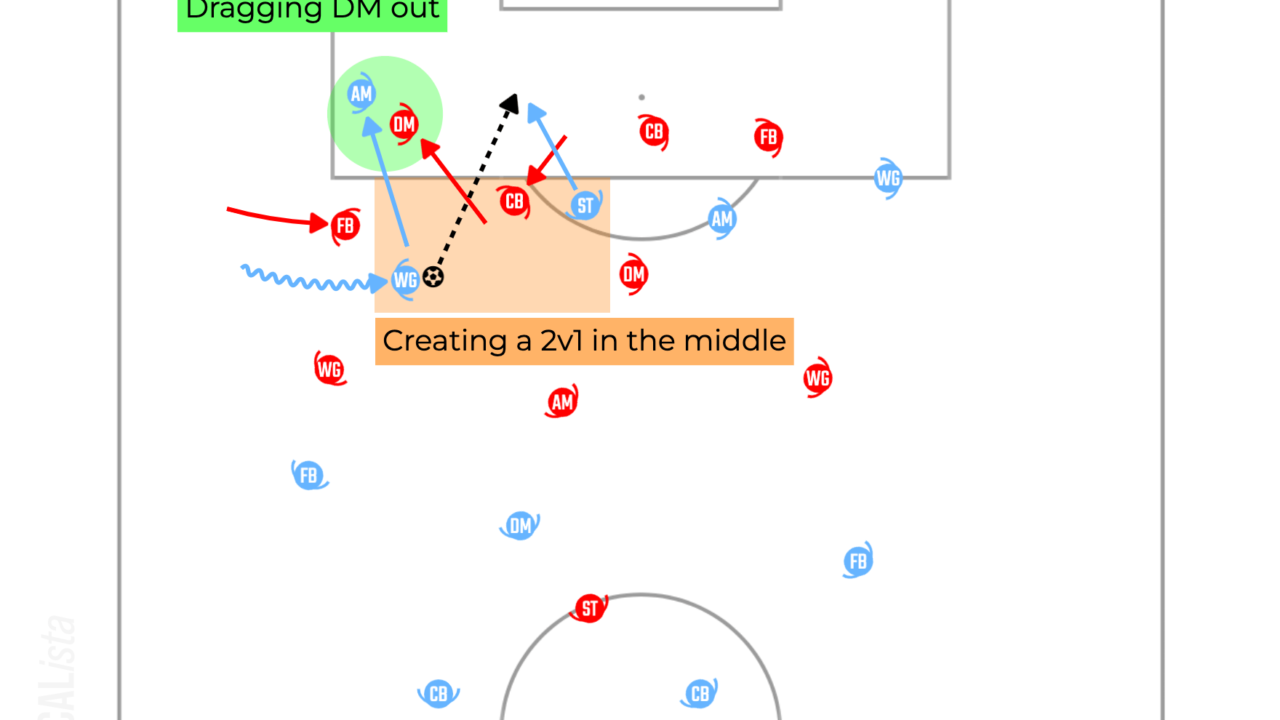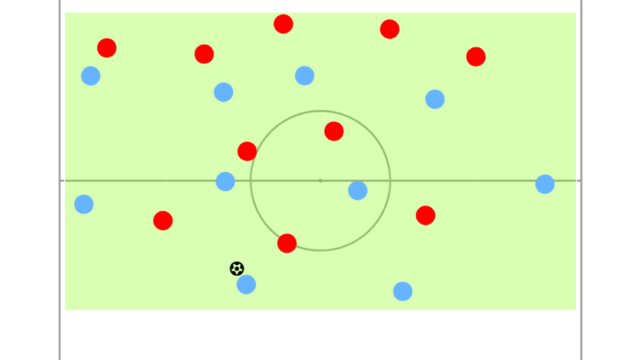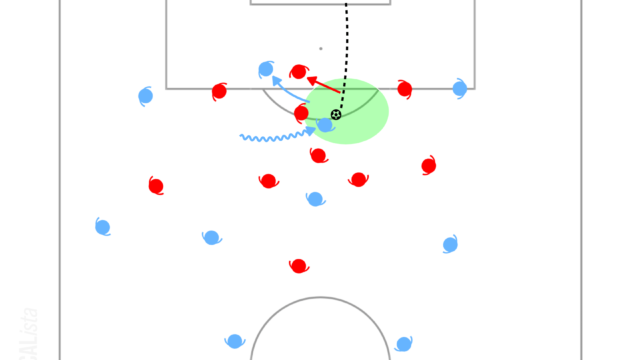Final Third Attacking Based on The Opposition Defensive Organisation [Football Tactical Analysis]

Introduction
It is extremely important to play in behind the opposition back line to disorganise the opposition defensive block and create gaps to create a goal scoring chance. Additionally, playing in behind can force the opposition defenders to turn their body angle, which also helps to lose the opposition markers to be free.
However, in the final third, since the space in behind is limited, the timing becomes crucial. To share the timing, it is useful to set a trigger to play in behind and the triggers are often related to how the opposition players to defend.
Therefore, in this article, how to play in behind in the final third is going to be explained based on how the opposition teams defend the space behind the back line.
When CBs Stay in front of the Goal
In the final third, since the goal is in the middle, some teams get the centre backs to stay in front of the goal to defend against crosses better. In this case, the channels, which are the space between a centre back and a fullback in each side, are likely to be stretched.
Then, who to exploit the space are going to be discussed. If the striker in the middle makes a diagonal run into one of the channels, there are mainly two risks. Firstly, one of the opposition markers of the striker can easily follow the movement. The situation where the channels are covered by the centre backs is going to be analysed in the next chapter though, this can result in narrowing the available space in the channel and lacking the threat in the box. Secondly, the run from the inside to outside makes it harder to face the opposition goal in the middle after receiving the ball. Therefore, it is not effective that the striker runs diagonally into one of the channels.

On the other hand, if the attacking midfielder or fullback make an underlapping run into the channel, there are some advantages. Since the striker can stay in the middle, it is possible to pin the opposition centre backs, which stretches the gap between the ball side centre back and fullback. Additionally, when the winger possesses the ball, it is difficult for the opposition defensive midfielder or fullback to keep an eye on the ball and the player who makes a run into the channel. After receiving the ball in the box, furthermore, the player can face forward and deliver a cross easier than the striker.

However, the attacking midfielders or fullbacks can receive the ball with a better angle to deliver a cross than the strikers, but when focusing on the movement towards the goal, a diagonal movement of the wingers towards the goal is much better. One of the most famous ways to break an opposition line is playing a one-two and the winger on the ball can make a diagonal run towards the goal after playing the first pass. Another way is playing over the opposition fullback’s head from the midfield or even centre back and the winger runs in behind from the blind side of the opposition fullback.

Of course, depending on how to organise rotations in wide areas, the position of wingers can be taken by the fullbacks, so the more important thing here is the positions of players on the pitch and not original positions of players.
Overall, in case when the opposition centre backs tend to stay in the middle and they do not have a clear plan to defend the space in the channels as a team, it becomes easier to play in behind through one of the gaps between the centre back and fullback. Additionally, in terms of movements in behind, the striker or players in the middle should focus on being in front of the goal and pinning the opposition centre backs and the players in wide channels can receive the ball in behind in the most effective situation.
When CBs Cover the Channels
The space in the channels can be covered by the opposition ball side centre back or defensive midfielder. Firstly, the case which the ball side centre back shuffles across to close the space in the channel is going to be discussed.
The reason why the centre backs often chose to stay in the middle instead of shuffling across as a line is the goal is in the middle and the opposition will definitely try to progress the ball towards the goal. In other words, if the centre backs keep defending as a line and the ball side centre back covers the space in the channel, it weakens the defensive structure in front of the goal. Therefore, as soon as the ball side centre back shuffles across towards the wide area, it is simple but extremely effective to deliver a cross in front of the goal.

Since there are only two defenders including the opposite side fullback who is likely to be less reliable than original centre backs at defending crosses, crosses become more dangerous for the opposition.
In the case when the winger receives the ball in behind with a diagonal run and the opposition ball side centre back steps out to deal with it, crosses towards the first post area becomes more effective. Usually, the ball side centre back drops back to the first post area, but if the centre back steps out, the opposite side centre back needs to cover longer distance to occupy that area, which often delays.

However, as the centre back tries to close the winger on the ball down, the winger is required to deliver a cross carefully to avoid being blocked by the opponent. To be fair, it is easier for the winger to keep the eye on the situation in front of the goal than any other players, so checking the opposition ball side centre back can help to deliver better crosses.
When DMFs Cover the Channels
Since the risk is high when the ball side centre back leaves the space in front of the goal and steps out to close the winger down, some teams get the ball side defensive midfielder or central midfielder to cover the space between the fullback and centre back.

In this case, it becomes more difficult for the attacking team to exploit the space in the channels when the opposition midfielder can cover the space. However, as the opposition midfielder drops into the back line, there are less opposition midfielders in front of the back line. Therefore, it is likely to be effective to dribble or play inside to create an overload against the opposition centre backs.

Using the run in behind as a decoy to get rid of the opposition defensive midfielder from the crucial area on the pitch can generate better chances than just playing in behind. Therefore, it is extremely important to always have two options, which are playing in behind to deliver crosses and playing inside to create an overload against the opposition centre backs.
When successfully playing in behind with a movement such as a diagonal run of the winger, cut backs become more dangerous. Since the opposition defensive midfielder steps out, the opposition back line can remain solid. However, the space where the defensive midfielder needs to cover is vacant. Therefore, cut backs towards the space in front of the opposition back line are effective against this type of defending.

As it was already mentioned in the previous chapter, of course the opposition defensive midfielder will try to close the attacker in behind down. Additionally, the underlapping runs in behind of the attacking midfielder or fullback are more difficult to face towards the goal than the diagonal runs of the wingers. In the case when the player who run in behind is forced to face towards the touch line and hold the ball up, support from the winger becomes crucial.

By making a run towards the goal, the winger can receive the ball from the player holding the ball up can have an option to play. Additionally, like cut backs, the winger can exploit the space where the opposition defensive midfielder left, so this combination is important.
Against A Back 5
So far, the discussion was based on when the opposition defends with a back four. However, the more difficult thing is how to play against a back five. Since the opposition has an extra centre back in the middle, even when successfully dragging the opposition wingback, there is tiny space in the channel. Additionally, thanks to the extra centre back, there is no need for the defensive midfielder to drop into the back line to defend the channel, so it is also difficult to find an option to play inside. Therefore, naturally the opposition can fill important areas with a back five, so it is extremely important to remove some of them to create space.
The defenders in a back five tend to focus on marking the opposition attackers rather than defending zonally. Otherwise, they need to apply pressure on the ball with the other five players, but it is difficult and eventually results in being pinned in the own half. Therefore, from the attacking perspective, it is a key to try to drag the opposition defenders out to create space to penetrate.
By playing towards the outside, it is possible to draw the opposition wingback out, but it is not effective as there are still four defenders in the box. Thus, dragging one of the centre backs out is more important.

The attacking midfielder drops to offer a passing lane for the centre back on the ball and also drag the opposition wide centre back out. This can create exploitable space in behind and as it has been already mentioned several times in this article, the winger should make a diagonal run towards the space in the box. After that, the situation is similar to what happens against a back four team because there are three defenders and one or two defensive midfielders to deal with a cross in front of the goal. Therefore, which type of crosses is suitable depend on who steps out to close the winger down.
However, especially when the winger possesses the ball in a wide area, it becomes more difficult to play into the box because the wide centre back is blocking the space in the channel. Therefore, as it was not favourable movement against a back four, one of the strikers in the middle is required to make a run in behind to make an overload and confuse the opposition middle centre back.

The striker making a run in behind may not receive the ball with facing towards the goal, but this movement can force the opposition middle centre back to stay or leave the space in front of the goal. If the opposition wide centre back decides to stay in the back line, the attacking midfielder can receive the ball freely in between the lines.
Additionally, to overcome the weakness which there is no threat when the striker drifts to the outside, one of the attacking midfielders or opposite side wingers needs to be positioned in the middle to receive early crosses in the box.
Overall, against a back five system, the key is removing one of the opposition wide centre backs to exploit the space in the box. Moreover, since there is an extra centre backs at the back, the striker might be required to make a run in behind to influence on the opposition middle centre back to create an overload in a wide area or drag the middle centre back out.
Conclusion
In this article, how to exploit the space in the box based on the opposition defensive structure was discussed. The exploitable space differs depending on the opposition defensive method or even the number of defenders at the back. Finally, some of the keys to exploit a back five system were identified. I hope you enjoyed this. Thank you for reading.


